|
 Pleurotus purpureoolivaceus Pleurotus purpureoolivaceus
SynonymsPleurotus rattenburyi
Resupinatus purpureoolivaceus
Pleurotus ostreatus
Lentinellus crawfordiae
Pleurotus crawfordiae
BiostatusPresent in region - Indigenous. Endemic
Images (click to enlarge)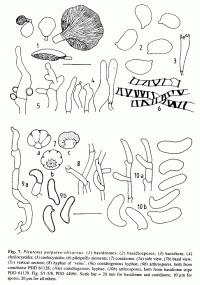 | 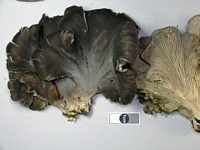
Owner: J.A. Cooper | 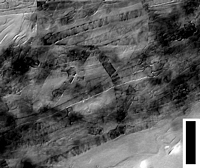
Caption: scale = 20um. cap hyphae with extracellular stripes.
Owner: J.A. Cooper | 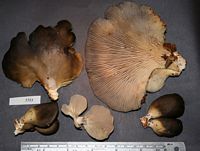
Owner: Herb PDD | 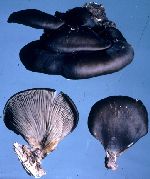
Owner: B.P. Segedin | 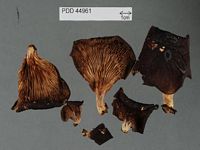
Caption: Dried type specimen
Owner: Herb PDD | 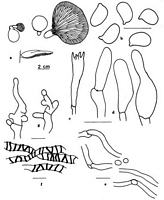
Caption: Fig. 1. a. habit; b. spores; c. basidium; d. cheilocystidia; e. gelatinized hyphae of upper
context; f. incrusted hyphae of pileipellis; g. caulocystidia. All lines 10 µm unless otherwise
stated. | 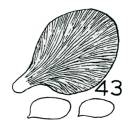
Caption: Fig. 43 | 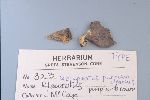
Caption: Type specimen, Kew
Owner: B.P. Segedin |
Article: Segedin, B.P.; Buchanan, P.K.; Wilkie, J.P. (1995). Studies in the Agaricales of New Zealand: new species, new records and renamed species of Pleurotus (Pleurotaceae). Australian Systematic Botany 8: 453-482.
Description: Basidiomes pleurotoid, sometimes imbricate; stipe present,
strongly excentric to almost lateral. Pileus 10-70 mm wide by 30-56 mm long,
broadly spathulate to flabelliform, broadly convex to flat, rubbery in texture;
surface matt, uniformly dark violet to deep brownish violet (15F7-14F5, K &
W), retaining colour on drying, smooth and moist but not viscid; margin slightly
inrolled when young, distinctly straight at maturity. Lamellae decurrent, 3-4
mm wide, pale silvery grey, thin, crowded, alternating with lamellulae of 3-4
lengths, some bifurcating towards stipe; edges very even. Stipe lateral, short,
5-15 mm x 5-10 mm wide, solid, pruinose, lilac-grey with yellowish tints (amber
yellow, K & W 4B6) at the base. Flesh thin, grey. Spore print white. Smell
and taste none.
Spores 6.5 - 9 x 4.5-5 (7.6 x 4.7)µm, hyaline, thin-walled,
inamyloid, cylindrical-elliptic to slightly phaseoliform, collapsing easily.
Basidia 37-40 x 6-8 µm, elongate-clavate, hyaline, sometimes with granular contents,
4-spored. Gill edge sterile; cheilocystidia crowded, varied in shape, cylindric-clavate,
more strongly clavate to broadly lageniform, 25 x 3-7 µm, thin-walled, hyaline,
all with conspicuous clamps at base; pleurocystidia absent. Pileipellis a thick
parallelocutis of distinctive incrusted to banded, clamped hyphae 4-7 µm diam.,
incrustations or bands deep purple-black in 3% KOH, congo red or Melzer's solution.
Context just-below the pileipellis of sub-parallel, light brown (some incrusted),
somewhat gelatinous hyphae 2-4 µm diam; rest of context hyaline, thin-walled
interwoven hyphae 4-6 (-7) µm diam, with occasional oleiferous hyphae with cyanophilic
contents. Lamellar trama similar to context but with scattered incrusted cells
appearing dark blackish-brown in 3% KOH and Melzer's solution; subhymenium well-developed,
pseudoparenchymatous.
Stipe surface densely covered with distinctive coralloid clusters of short
caulocystidia 11-35 x 7 µm, hyaline, with large clamp connections; some cystidia
with thickened walls, others with hair like extensions.
Habitat: Mainly on wood of Nothofagus species; one record on tree lucerne
Article: Segedin, B.P. (1984). A new species of Pleurotus (Agaricales) in New Zealand. Tane 30: 235-238.
Description: Basidiomes pleurotoid, sometimes imbricate; stipe present, strongly excentric to almost
lateral. Pileus 10-70 mm wide by 30-56 mm long, broadly spathulate to flabelliform,
broadly convex to flat, .rubbery in texture; surface matt, uniformly dark violet to deep
brownish violet (15F7-14F5, K & W), retaining colour on drying, smooth and moist but
not viscid; margin slightly inrolled when young, distinctly straight at maturity. Lamellae
decurrent, 3-4 mm wide, pale silvery grey, thin, crowded, alternating with lamellulae of
3-4 lengths, some bifurcating towards stipe; edges very even. Stipe lateral, short, 5-15
mm x 5-10 mm wide, solid, pruinose, lilac-grey with yellowish tints (amber yellow, K &
W 4B6) at the base. Flesh thin, grey. Spore print white. Smell and taste none. Spores 6.5
- 9 x 4.5-5 (7.6 x 4.7)) µm, hyaline, thin-walled, inamyloid, cylindrical-elliptic to slightly
phaseoliform, collapsing easily. Basidia 37-40 x 6-8 µm, elongate-clavate, hyaline,
sometimes with granular contents, 4-spored. Gill edge sterile; cheilocystidia crowded,
varied in shape, cylindric-clavate, more strongly clavate to broadly lageniform, 25 x 3-7 µm,
thin-walled, hyaline, all with conspicuous clamps at base; pleurocystidia absent. Pileipellis a thick
parallelocutis of distinctive, incrusted to banded, clamped hyphae 4-7 µm diam., incrustations or
bands deep purple-black in 3%v KOH, congo red or Melzer's solution. Context just below the
pileipellis of sub-parallel, light brown (some incrusted), somewhat gelatinous hyphae 2-4 µm diam;
rest of context hyaline, thin-walled interwoven hyphae 4-6 (-7) µm diam, with occasional oleiferous
hyphae with cyanophilic contents. Lamellar trama similar to context but with scattered incrusted
cells appearing dark blackish-brown in 3% KOH and Melzer's solution; subhymenium well-developed,
pseudoparenchymatous. Stipe surface densely covered with distinctive coralloid clusters
of short caulocystidia 11-35 x 7 µm, hyaline, with large clamp connections; some cystidia with
thickened walls, others with hair-like extensions.
Notes: The larger form quoted by Stevenson (1964) under P. ostreatus as having yellow gills is also a
Pleurotus but not P. rattenburyi.
This very distinctive fungus was found in great quantity as the first invader of fallen trees following
extensive killing of Nothofagus, the cause of which is not yet fully established, but may be
associated with the frequent presence of Armillaria limonea (Stev.) Boisewinkel and A. novae-zelandiae (Stev.) Boisewinkel on Nothofagus in the area.
This fungus was first recorded for New Zealand by G. Stevenson (1964) as Pleurotus ostreatus
(Jacq. ex Fr.) Kummer, collected at Levin on a tree lucerne stump by A.S. Wilkinson, 1 August,
1952 (Stevenson 874, K). The material at Kew has been examined and found to be identical with the
material described in this paper. This fungus certainly has the appearance of some of the dark bluish-black variants of P. ostreatus but it differs from the published descriptions in a number of respects.
P. ostreatus usually has a lilac spore print. It does not have the rubbery texture of P. rattenburyi
when fresh, the spores are elongated to cylindrical, the lamellae are broader and well-spaced and
creamy-white to ivory and the margin of the pileus is strongly inrolled.
Article: Stevenson, G. (1964). The Agaricales of New Zealand: V. Kew Bulletin 19(1): 1-59.
Description: Pileus 3.5 cm diam., olivaceous to purplish olivaceous, orbicular, moist at first becoming velvety; flesh ochraceous. Gills decurrent, moderately crowded, long and short intercalating, dull ochraceous with purplish tint. Stipe 0.5 x 0.5-1 cm, lateral, velvety to fibrillose, ochraceous. Spores 6-8 x 3-4.5 µm, non-amyloid, thin-walled (Fig. 43) Cuticle of loosely woven hyphae up to 5 µm diam. Spores smooth
Habitat: On fallen wood, Butterfly, Wellington, 26.6.1948, J. McCan in Stevenson (type).
Article: Horak, E. (1971). A contribution towards the revision of the Agaricales (Fungi) from New Zealand. New Zealand Journal of Botany 9(3): 403-462 (http://www.rsnz.org/publish/abstracts.php).
Notes: Resupinatus purpureo-olivaceus Stevenson (29 D) = Anthracophyllum sp.
Article: Stevenson, G. (1964). The Agaricales of New Zealand: V. Kew Bulletin 19(1): 1-59.
Description: A small form of this widespread species, closely similar to that illustrated by Lange (1936), was collected at Levin on a tree lucerne stump by A. S. Wilkinson, 1.8.1952. This collection, Stevenson 874, had a sour smell when fresh, but anatomical characters and spores agree with descriptions of this species. A larger form with yellow gills was collected from indigenous forest by M. Curran, at Muritai, 12.2.1958.
Notes: [mixed collections and description]
|